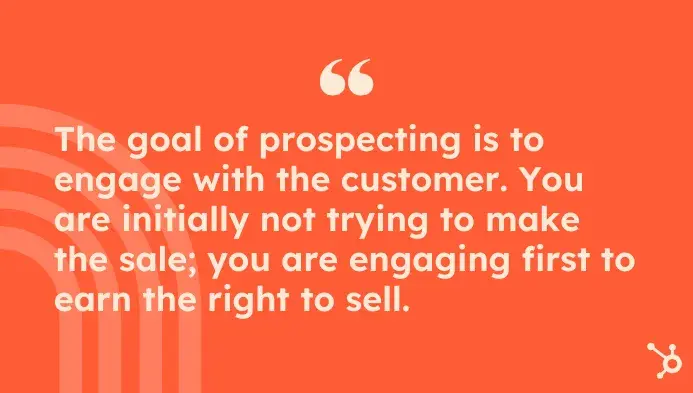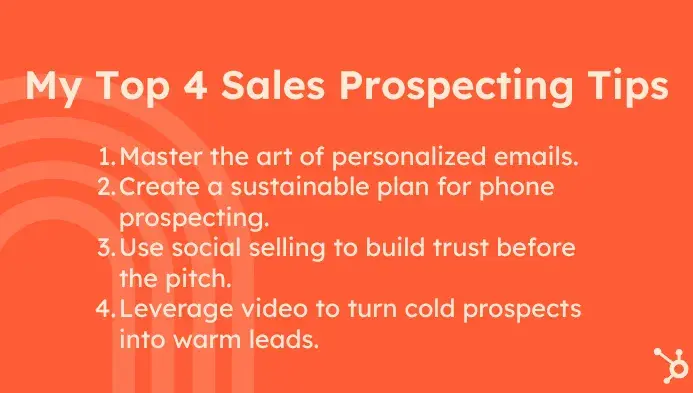When I started in B2B sales and my real phone sales prospecting journey began, I quickly realized I was lost.
I was overwhelmed with the process of identifying the right industries, customer profiles, and decision-makers — not to mention finding the best phone number and email addresses to reach the prospect. I knew prospecting was a non-negotiable in sales, but I needed clarity and structure to guide me.
So, I created a sales prospecting plan centered on personalized emails, sales video messages, and targeted research for effective phone prospecting. This plan helped me find a groove that worked for me, and not only to hit quota but also to remain productive.
In this post, I’ll walk you through the exact plan I used, how I approached it, and I’ll share my sales prospecting tips so you can build a rhythm that works for you.
Table of Contents
Why Sales Prospecting Matters
As a sales coach, I talk to my students a lot about prospecting and why it matters. Here is the main point I share with them first:
The goal of prospecting is to engage with the customer. You are initially not trying to make the sale; you are engaging first to earn the right to sell.
Once I learned that, I was able to get creative in the ways I could engage with the prospect.
Here are some of the things I did that I’ll go into in detail later on in the post:
- I created a plan to send out sales video messages through social selling.
- I personalized emails to increase my sales email response rates.
- I conducted targeted industry research to enhance my cold-calling phone prospecting.
One important thing to note is that sales prospecting varies across all industries. This is because each industry deals with a different customer, and you must tailor your prospecting to that ideal customer profile (ICP).
I’m going to go into a little more detail on this, and then I’ll get to my tips.

What Sales Prospecting Looks Like in Different Industries
B2B, Tech, and SaaS Sales
The B2B, tech, and SaaS sales prospect foundation is set on consistency. Efficient B2B prospecting ensures a consistently filled sales pipeline, an accelerated sales cycle, and optimized outreach campaigns.
Pro tip: In B2B sales, I knew my prospecting plan had to yield consistency over results. The results of hitting and maintaining quota are essential, but to achieve that, your foundation must be set to manage your metrics effectively. Having a prospecting plan does just that.
Healthcare and Non-Profit Sales
In emotionally sensitive industries like these, prospecting requires empathy, curiosity, and genuine listening. Emotional intelligence helps you build rapport with leads.
Pro tip: I don’t have experience in these industries, but I have developed my emotional intelligence in sales. My advice is to ensure that all prospecting channels focus on the customer’s needs, allowing you to personalize outreach with care and build rapport at the first touchpoint.
Finance and Insurance Sales
Prospecting in highly regulated or skeptical industries like these often results in more rejections. It is essential to establish that you are a genuine individual and not someone seeking to make false claims. Your prospect has to know, like, and trust you.
Pro tip: I worked in banking; personalized video follow-up messages after a phone call were always the white-glove service that allowed me to further connect with customers, earning their trust in the business.
Enterprise and Consultative Sales
Sales prospecting in the enterprise and consulting industries resembles creating a curiosity-driven learning experience. Enterprise buyers expect sellers to know their business.
Effective prospecting is essential here to rely on research, business acumen, and strategic curiosity. Curiosity-driven selling is a thing for a reason, and according to the Global Risk Community, studies show it leads to stronger relationships.
Pro tip: While I was working in consultative sales, phone prospecting was crucial because it enabled me to dive deeper into the conversation with the customer. Coming from a consultative approach allowed me to ask the right questions from a curious standpoint, and it made me appear more knowledgeable about the product I was selling. I didn’t come across as salesy, but rather full of worthwhile suggestions based on the questions I asked, and that alone positioned me as the expert.
My Top Sales Prospecting Tips
Regardless of which industry you’re selling in, I’ve learned the best practice is to create a prospecting plan to enforce consistency in your approach. The following four tactics were ones I kept in my toolbox and used regularly. Read on for details and tips.

Tip 1: Master the art of personalized emails.
Email prospecting involves sending personalized or templated cold emails to potential prospects to establish a relationship, schedule a meeting, or spark interest.
In my sales role, I wanted email prospecting to be my go-to outreach strategy because I excel at forming emotional connections through words, and I enjoy writing. I also felt prospects would open up an email before picking up a cold call.
So, I would set aside time every week to conduct thorough research on the prospect to highlight in my personalized emails, and it worked. I would also automate my template emails to have those sent out behind the scenes while I worked on the customized emails.
The results? I consistently booked meetings through email prospecting.
How to Implement This Tip
- Create your prospecting plan, whether that be daily or weekly, and decide how you want to structure your email strategy for outreach.
- Determine how many personalized emails you want to send versus how many template emails you wish to send. (I set a goal of sending out 10 personalized research emails daily.)
- Hone the aesthetics of your prospecting email, including the subject line, introduction, value proposition, invitation, closing signature, and other key elements.
What to Track
To monitor your email prospecting, here is what I recommend:
- Track key metrics such as open rates, response rates, click-through rates, and conversion rates.
- Then, identify areas for improvement or areas that can be doubled down on.
Tip 2: Create a sustainable plan for phone prospecting.
Phone prospecting is making cold calls to identify, qualify, and engage with potential clients or customers. Since phone prospecting accounts for the majority of sales activity, you want to be intentional about the calls you decide to make in your prospecting plan.
The rate that made a significant impact on my performance was the connection rate. Instead of worrying about the calls I made, I was trained to focus on the number of prospects I connected with daily. That shifted focus increased my call confidence, allowing me to see the big picture.
How to Implement This Tip
- Set up a daily phone prospecting plan to determine the number of cold calls you would like to make each day. Choose a number that is achievable and not extreme.
- Set a schedule and number of dials that work for you (my number was 50 a day), taking into account your energy level, and adjust as needed.
- Once you reach your goal number of dials, you will have the space to call more without feeling the pressure of meeting an unrealistic target that is difficult to manage daily.
Pro tip: With my cold calling, I would base it on the Eat That Frog concept of “doing the hardest thing first.” If you prefer morning dials, make that your time block; if you prefer evening dials, make that your call block.
What to Track
- To monitor your phone prospecting, track key metrics such as call volume, connections, and conversion rate.
Tip 3: Use social selling to build trust before the pitch.
Social selling utilizes social media channels to build awareness, foster relationships, and attract prospects, enabling connections and generating leads.
Social selling is powerful when done right. In fact, 92% of financial professionals who use social media for business say that it has helped them gain new clients.
Still, social selling faces significant resistance as social media can be challenging to stay consistent with. Sales representatives who utilize social selling typically have an existing following, are extroverted, and are willing to develop their brand to attract prospects and buyers.
It was challenging for me at first, but I started social selling very slowly by sharing the value of the industry I was selling in. I would share articles, tips, and expert advice, and include my takeaways to present myself as knowledgeable and aware of my industry.
How to Implement This Tip
- My advice for your social selling prospecting plan is to choose a platform that suits your personality and start small, gradually building up your presence.
- Share what works for you and don’t force it to be like others’ posts on social media.
- Create a content calendar of posts you want to share for the week and adjust accordingly. You could create article research posts on your industry, as I shared what worked for me, or you can create posts based on your point of view and expertise as a sales representative in your industry.
Pro tip: The key to social selling is that you must commit to the long haul; you won’t receive prospects as soon as you make a post, nor should you expect your posts to go viral. Social selling takes time, but it can be effective in the long run.
What to Track
- To monitor your social selling track key metrics such as engagement rates, inbound leads, and connection rate.
Tip 4: Leverage video to turn cold prospects into warm leads.
Video prospecting utilizes video as a strategic outreach tool to connect, engage, or educate prospects. I don’t think video prospecting is discussed enough as an effective sales outreach strategy. Like social selling, it can be intimidating, but it’s also extremely valuable.
In my career, I wanted to excel at video prospecting because it allowed me to be creative and effectively showcase my personality, unlike other outreach methods. I learned about video prospecting through Vidyard.
I watched several tutorials on Vidyard to learn how to develop sales video messages and took action by incorporating them into my prospecting plan. I would send out five videos a day using the Vidyard platform.
Another async video communicator you could use is the platform Loom. Creating videos utilizing Loom can work best in social selling because you can share the link directly within direct messaging.
How to Implement This Tip
- When creating your video prospecting plan, determine how many videos you would like to send on a daily or weekly basis.
- Create practice videos to become comfortable talking in front of the camera. Start with a few videos to get started, and increase the number as your comfort level improves.
- Additionally, consider the time it takes to create these videos and how long you want them to be in your messaging. My videos were no longer than two minutes. Keep it short and straightforward; there’s a lot you can say in little time, and the point of the video is to connect and engage.
What to Track
- To monitor your video prospecting, track key metrics such as watch time, engagement, and click-through rates.
What Works in Prospecting Today
Phone prospecting is the most effective outreach strategy, and it remains undefeated when you lead with clarity and care. I regularly used all the tips and tactics I shared with you here, and they all worked for me in their own way.
There’s no one-size-fits-all when it comes to prospecting. But what does work is being intentional and human across every channel, and showing up consistently with a plan in place.
When you incorporate these sales prospecting tips into your sales workflow, you will build trust and foster relationships, ultimately driving sales.
![]()


